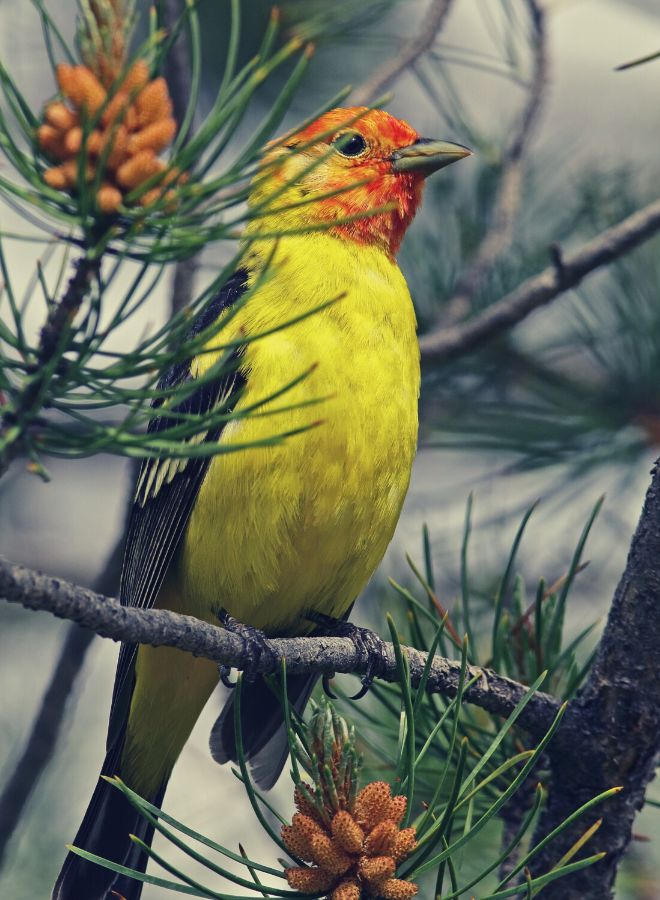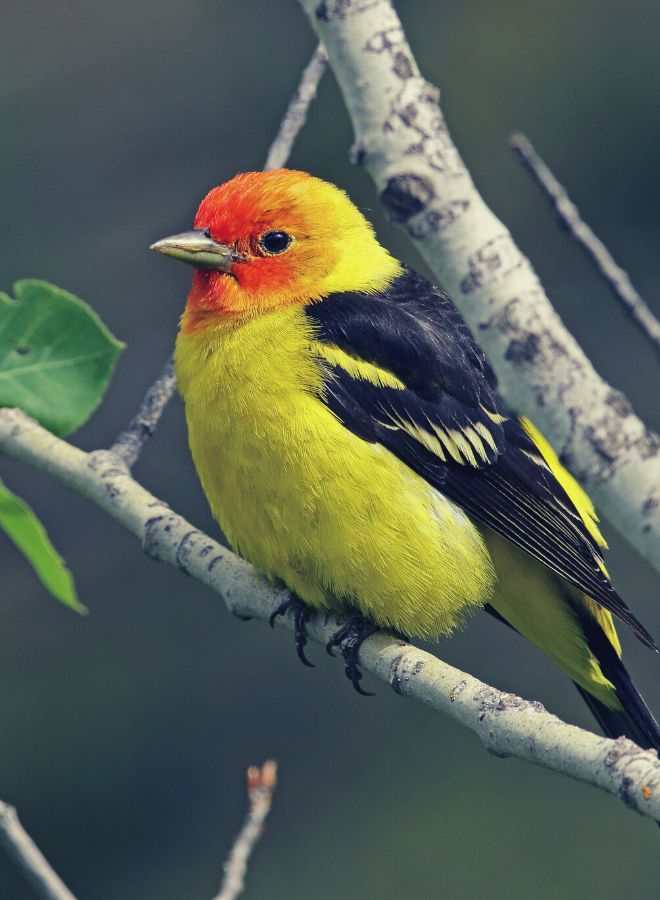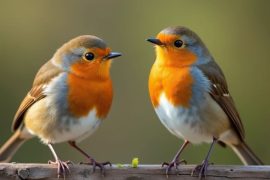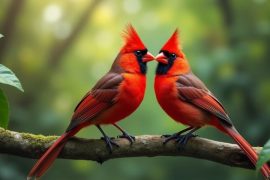The brightly colored western tanager holds deep spiritual meaning for many. With its vivid red and yellow plumage, this small songbird stands out against the forests it inhabits. For Native American tribes, the sight of a western tanager was considered a sign from the divine realm. What messages might this sacred bird have for us today?
Tanagers in Native American Tradition
Western tanagers were seen as messengers by many indigenous tribes. Their bright colors connected them to the sun and were seen as otherworldly. Some believed tanagers transformed into birds from flowers. They often appeared in Native art and stories as signs of good fortune. The Cherokee saw the tanager as a healing animal, with the power to bring renewed energy.
Tanagers had a strong presence in the myths and folklore of tribes like the Cherokee, Navajo, and Shoshone. Their vivid red-and-yellow plumage made them stand out, unlike any other bird. This unique appearance led tribes to associate tanagers with the supernatural realm, as if they had flown out of a dream world. Some stories tell of tanagers being gifts sent from the Creator, intended to lift the spirits of humanity with their beauty.
In the stories and art of Southwestern tribes like the Pueblo and Hopi, tanagers were portrayed as messengers between worlds, delivering prayers from the people to the divine beings above. Shamans would interpret the sight of a tanager as a sign to stop and listen—guidance from the spirits was coming. Many believed that mystics and medicine men could transform into tanagers to fly swiftly between this world and the realm of the gods.
Overall, tribes viewed the tanager as a positive omen. Spotting one for the first time each spring indicated the season had truly turned. They were seen as heralds of the warmer months ahead. Their arrival brought renewed hope after the cold darkness of winter. Some Plateau Indian tribes believed seeing a tanager on the first hot day of spring could grant you protection from heat-related illness.
The Meaning Behind Its Colorful Plumage

The tanager’s red and yellow feathers hold symbolic wisdom. Red represents strength, passion, and stimulation, while yellow embodies joy, optimism, and mental clarity. Together they indicate a spirit unhindered by fear, full of vibrant energy. The contrast shows a balance of groundedness and enlightenment.
The piercing red plumage of the tanager was associated with vitality, confidence, and the life force by many tribes. Reds and yellows were sacred colors in many indigenous cultures. In Hopi ritual art, red symbolized the earth and the attainment of wisdom. For the Zuni people, red stood for summer, the south, warmth, and the passion of life. Yellow represented enlightenment, beauty, and mental clarity. Together, these colors created a symbolic bridge between the physical and spiritual realms.
Some tribes saw the tanager’s contrasting hues as a representation of balance. The warm, stimulating shade of red balanced with the energizing, uplifting quality of yellow. This bridged groundedness and intuition. The striking color combination also symbolized the balance between the masculine and feminine energies. The valor and strength of red complemented the illumination and openness of yellow.
In Cherokee culture, red and yellow were considered sacred colors associated with the directional realms of east and north respectively. East represented confidence and triumph, while north embodied wisdom and guidance. Therefore, the tanager embodied the union of these powers – success joined with insight. Their scarlet feathers specifically symbolized the life-giving energy of the rising sun each morning.
Messages About Creative Expression
The complex song of the tanager inspires creativity. Their scarlet wings were seen as the lifeblood of creation itself. Spotting a tanager may be a prompt to share your own voice and talents with the world. This bird encourages free-flowing creativity and lightheartedness.
The flute-like song of the tanager was said to inspire artists, dancers, and weavers by some tribes. They believed catching the melody of the tanager could kindle new ideas and innovations. In Navajo culture, the scattered notes of the tanager’s tune were thought to stimulate creativity and imagination in a way no other bird could. Hearing this joyful, complex song was seen as a sign to try something new.
Some origin stories say the tanager’s song came from the Creator, intended to awaken human creativity. By echoing this holy melody, the tanager stirs our innate originality. Tribes would listen closely to tanagers to try to learn their songs and weave them into new dances, poems, or music. The scattering of notes inspired the creation of new patterns and expressions.
In the artwork of Southwestern tribes like the Acoma and Hopi, tanagers were usually depicted in motion with their beaks open mid-song. Capturing them in this moment of melodious expression was thought to convey the essence of creativity itself. Some archaeologists believe prehistoric petroglyphs of songbirds may actually be red tanagers, indicating these birds were artistically inspiring even hundreds of years ago.
Furthermore, tanagers seem to dance as much as they sing. Their acrobatic flights through treetops, full of dips and twirls, reflect their playful spirit. Some tribes saw in the tanager’s midair dances reminders to approach life and creative acts with joy and lightheartedness. They believed having fun was a key to unlocking new innovations.
Tanagers as Spirit Guides

Some believe the tanager can connect us to higher guidance and serve as a spirit guide. Its appearance signifies a time for inner wisdom and renewal. You may be entering a period of inspiration. Meditate on the tanager to tap into its hopeful energy and direction.
In some Native traditions, medicine men would call on the tanager as a spirit guide to assist in divination rituals. Through dances and chants, they would summon the presence of the tanager and request it reveal visions to help diagnose illnesses or reveal coming events. By flying between the mundane and spiritual realms, tanagers were thought able to channel prophetic insights.
Individuals also sought out tanagers as personal spirit guides. Spotting one after making an offering or prayer was taken as a sign your request had been heard and the tanager had arrived to support you. People would meditate on images of tanagers or say prayers asking for these colorful birds to strengthen and enlighten them through trying times.
When a tanager appears to you, it may signal a need to pause and seek wisdom within. The bright plumage catches the eye and asks you to stop focusing externally for a moment. Some see the tanager as a reminder to open your inner eye – your intuitive sight. Take time when it appears to listen for inner guidance by meditating or communing with nature.
You may find the tanager arrives at key moments of transition in your life’s journey. His brilliant hues light the way forward towards growth and renewal. If you feel lost in shadow, pray to the tanager for illumination and vision. See him as a torch in the darkness, stepping in to guide you into a new stage of enlightenment.
The Tanager As a Symbol of Joy and Optimism
The bright yellow plumage of the tanager also connects it strongly with joy and optimism. When you see a tanager, it may be a sign to appreciate life’s blessings or view challenges in a positive light. The tanager’s cheerful coloration reminds us to nurture hope and gratitude even in difficult times.
Many tribes saw the tanager as a herald of warmer, brighter days after the cold darkness of winter. Their return each spring brought renewed hope and energy. To see them darting through greening forests filled people with the sense that the world was renewing itself. The tanager’s vibrant plumage evoked the radiance of spring after an icy winter.
In this way, tanagers came to symbolize resilience and rebirth to many tribes. Their dramatic return reflected nature’s ability to regenerate itself. Just as glacial nights gave way to sunny spring days, the tanager signals better times even in our darkest hours. They remind us winter’s chill always melts into flowing streams and blossoming flowers.
Moments when a tanager crosses your path may indicate it’s time to look up from darkness and see the light ahead. Let the tanager rekindle optimism within you even when circumstances seem bleak. Know brighter days will arrive. Have faith, stay patient, and perceive the beauty around you. The tanager blazes like a flame through shadows, assuring us the sun always rises again.
Conclusion
The western tanager’s beauty holds rich meaning. For many, it represents joy, inspiration, and the call to express one’s true colors. This sacred messenger offers renewed vision and creative energy.
Native American tribes revered the tanager for its otherworldly plumage and musical voice. They saw it as a positive omen and source of wisdom. The contrasting yellow and red symbolize optimism balanced with groundedness.
Seeing a tanager may remind you to open to inner guidance, dance with lightheartedness, and awaken your creative spirit. During dark times this bird can rekindle hope and resilience. In bright moments it amplifies joyful appreciation. However it crosses your path, the tanager illuminates new possibilities.



